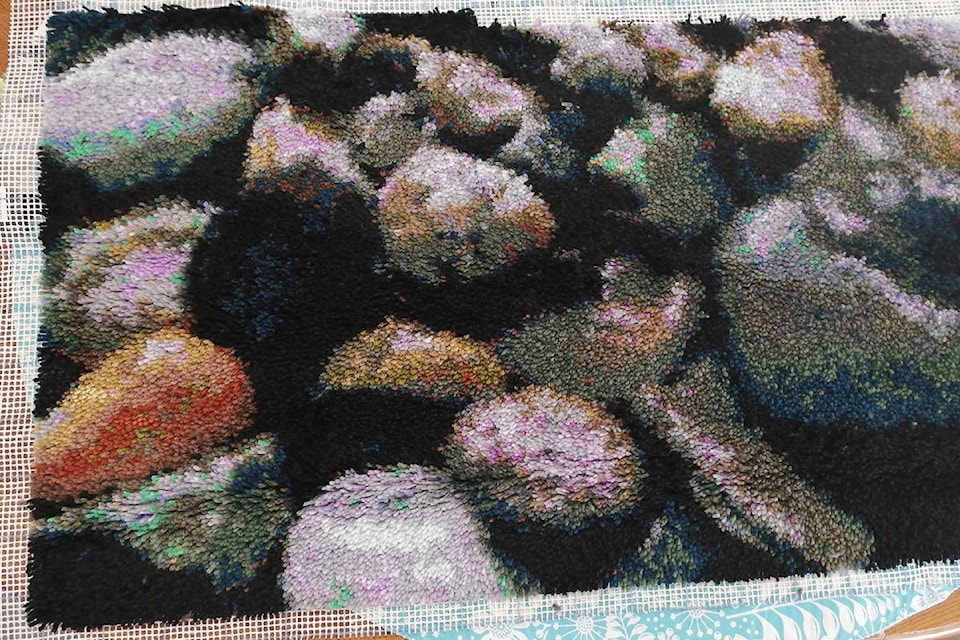It took a pandemic to get Maureen Schaber to pick up her latch hook again.
Years ago, Schaber grabbed a half-finished latch hook project for a dollar at the flea market.
“I finished that one and quite enjoyed it,” she said in a phone interview from her home in Harrison. “I bought a piece of latch hook canvas … thinking that someday I would design something of my own. But that never happened, so it sat in the closet.”
The 74-year-old was never able to find time in her schedule; although retired, she spent several days a week volunteering in the chapel at local prisons. Then, in March of 2020, British Columbia was hit with its first wave of restrictions to combat the COVID-19 virus. People hunkered down in their homes, and Schaber’s volunteering stopped.
“Now I had all week to myself, and I thought, maybe I can do something with that” latch hook project, she said, “since we don’t know how long this is going to last.”
SEE ALSO: Out on a Limb: What I learned from living through a pandemic
Latch hooking is the process of knotting short pieces of yarn onto a stiff woven backing using a tool rather like a crochet hook. Often used to create rugs or cushion covers, it can also result in wall hangings, which is what Schaber had decided to attempt.
She created her own design from a photo of river rocks, using an online program called Left Source, ordered more than 22,000 pieces of yarn in 22 different colours, and waited for it all to arrive.
Although she got the everything started in March, it was May before she could really begin to work on the wall hanging. (An error in online shopping ended up with Schaber receiving 28 packages of gold yarn instead of black, and with COVID-19 closing the borders between Canada and the U.S., where Schaber bought the yarn, the error took longer to correct.)
The process, she said, was painstaking.
“I can’t work probably more than an hour at a time. It’s just too tedious,” she said. Working row by row, section by section, Schaber spent the pandemic building up her latch hook. Now, almost a year after she first decided to get started, it’s almost complete.
“It’s really exciting that it’s coming to the end,” she said. But it won’t be the end of her crafting.
With the river rocks almost finished, Schaber is thinking of creating her own design from scratch — “it would be pretty abstract, maybe streaks and swirls” — and continuing the craft she started to fill her weeks that COVID-19 had emptied.
But latch hook hasn’t been her only project. In the 1970s, Schaber had spent a year and a half living in Japan, and only now had the time to turn the photos in to a scrapbook.
“I’ve never done scrap booking before. And I probably never will again,” she said, then laughed.
SEE ALSO: Hindsight 2020: How do you preserve a year many Canadians would rather forget?
Her other main project is her journal.
“I started it just around the middle of March when things were shut down,” she said. “I don’t know if I had some intuition that this is going to be a bit of an adventure, I better chronicle it.”
Currently, Schaber has around 100 pages of typed notes on her time during the COVID-19 pandemic, including images and clippings from newspapers and Dr. Bonnie Henry briefings. The journal is not for publication, she said.
“But it will be interesting for me to go back to,” she added, “and if I do ever decide to write about my life, it will at least have this part in detail.”
Do you have a project you’ve been working on throughout the COVID-19 pandemic? We’d love to hear about it. Drop us a line by email (news@ahobserver.com) or over the phone (604-796-4302) to let us know what you’ve been up to.
news@ahobserver.com
Like us on Facebook and follow us on Twitter
